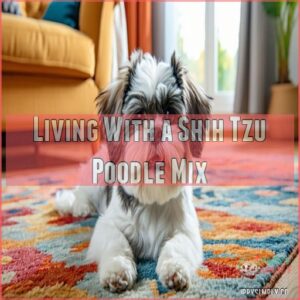This site is supported by our readers. We may earn a commission, at no cost to you, if you purchase through links.
 You’ll fall in love with a shih tzu poodle mix, a charming hybrid that combines the Shih Tzu’s loving nature with the Poodle’s smarts.
You’ll fall in love with a shih tzu poodle mix, a charming hybrid that combines the Shih Tzu’s loving nature with the Poodle’s smarts.
These adorable furballs typically weigh 8-18 pounds and sport a fluffy, low-shedding coat that can range from straight to curly.
They’re perfect apartment companions who’ll stick to you like glue – imagine a teddy bear that follows you around!
While they’re not marathon runners, they’ll happily bounce through a play session, then cuddle up for movie night.
Their gentle personality makes them natural therapists, but those puppy-dog eyes might just be their secret weapon for scoring extra treats.
Table Of Contents
- Key Takeaways
- Shih Tzu Poodle Mix Origin
- What is a Shih Tzu Poodle Mix
- Physical Characteristics of Shih Tzu Poodle Mix
- Shih Tzu Poodle Mix Temperament and Personality
- Training and Exercise Needs of Shih Tzu Poodle Mix
- Grooming Needs of Shih Tzu Poodle Mix
- Common Health Concerns of Shih Tzu Poodle Mix
- Diet and Nutrition for Shih Tzu Poodle Mix
- Living With a Shih Tzu Poodle Mix
- Cost of Owning a Shih Tzu Poodle Mix
- Frequently Asked Questions (FAQs)
- What is a Shih Tzu and Poodle mix called?
- How big will a poodle Shih Tzu mix get?
- How expensive is a Shihpoo?
- Is a Shihpoo a good dog?
- Do Shih Poos get along well with other pets?
- What size home is best for a Shih Poo?
- How long can Shih Poos be left alone?
- Are Shih Poos good with young children?
- Which generation of Shih Poo makes the best pet?
- Conclusion
Key Takeaways
- You’ll find Shih Poos are intelligent and easily trained, making them great companions.
- You’ll need to commit to regular grooming to maintain their coat.
- You’ll discover they’re adaptable and friendly, suitable for various lifestyles.
- You should budget for their ongoing health and care expenses.
Shih Tzu Poodle Mix Origin
You’ll find the charming Shih Poo’s story begins in the early 2000s when breeders wanted a dog that would require less tear stain management through diet, and choosing the right best dog food for shih tzus can help with that, mixed the ancient Shih Tzu with the smart Poodle to create the perfect companion dog.
While you won’t find this adorable hybrid in the American Kennel Club registry, their rising popularity proves that sometimes the best things in life aren’t official – just ask any Shih Poo parent who’s been won over by their furry friend’s winning personality.
Parent Breeds and History
Two remarkable breeds came together to create the lovable Shih Poo. The Shih Tzu, once treasured by Chinese emperors, brings its royal heritage as the "Lion Dog" to the mix. Meanwhile, the Poodle‘s German roots trace back to its days as a skilled duck hunter and truffle finder.
Both parent breeds share fascinating histories:
- These small, regal dogs, with their lion-like appearance inherited, were bred as royal companions. Picture Tibetan monks carefully breeding Shih Tzus in ancient monasteries
- Imagine German hunters wading through marshes with their loyal Poodles
- Envision Chinese palace gardens where Shih Tzus entertained royalty
- See clever Poodles sniffing out precious truffles in French forests
- Think of both breeds winning hearts in modern show rings
The unique blend of these histories creates something special in your Shih Poo.
Development as a Designer Breed
The rise of designer dogs in the early 2000s brought us the charming Shih Poo, a thoughtfully crafted mix that’s stolen countless hearts.
You’ll find this blend combines the best of both worlds – the Poodle’s smarts and the Shih Tzu’s loving nature.
Here’s what makes them special:
| Feature | Poodle Parent | Shih Tzu Parent |
|---|---|---|
| Coat | Low-shedding, curly | Silky, flowing |
| Size | Toy/Miniature | Small |
| Temperament | Intelligent, active | Affectionate, loyal |
While not recognized by major kennel clubs, these pups have gained quite a following among families seeking a smart, loving companion that fits perfectly into modern living spaces.
What is a Shih Tzu Poodle Mix
Mixing the loyal Shih Tzu with the intelligent Poodle creates a charming hybrid known as the Shih Poo, which, like other popular mixed breeds such as Labradoodles and Goldendoodles, combines the best traits of both parent dogs – think of it as getting the royal treatment of a Shih Tzu with the brainy wit of a Poodle.
While they’re not recognized by major kennel clubs, Shih Poos have won hearts since the early 2000s as perfect companions for families, singles, and seniors.
They’re especially popular among folks who want a small, affectionate pup that’s relatively easy to maintain.
Physical Characteristics of Shih Tzu Poodle Mix
You’ll find that your Shih Poo’s looks are as unique as their personality, with features ranging from curly Poodle-like coats to the adorable round eyes of a Shih Tzu.
Whether you end up with a tiny 8-pound cuddle bug or a slightly larger 16-pound charmer, you’re guaranteed to have a head-turning pup that’ll make everyone at the dog park ask, "What kind of dog is that?
Coat and Color Variations
Sporting a unique blend of their parent breeds’ best features, your Shih Poo’s coat could be straight like a Shih Tzu’s or curly like a Poodle’s – sometimes it’s a delightful mix of both!
These hypoallergenic coats come in eye-catching patterns and colors:
- Classic solids: black, white, brown, or cream
- Multi-color combinations: black and white, brown and white
- Rare finds: silver, red, or brindle patterns
For regular grooming, invest in the right Shih Poo clippers.
Want to keep that gorgeous coat manageable? Regular trimming’s your best friend!
Size and Weight Ranges
Depending on which Poodle size was used in breeding, your Shih Poo can range from tiny to small-medium.
When paired with Toy Poodles, these pups typically weigh 4-10 pounds and stand 8-10 inches tall.
Miniature Poodle mixes are slightly larger, reaching 10-15 pounds and 10-12 inches in height.
Like a perfectly sized teddy bear, they’re just right for cuddling in your lap or carrying in a doggy bag.
Facial Features and Body Type
Your Shih Poo’s adorable face combines the best features of both parent breeds.
You’ll notice their expressive, round eyes that sparkle with intelligence, often in warm brown or deep black.
Their compact body typically stands 8-13 inches tall, with a sturdy frame that’s neither too delicate nor too bulky.
The tail, usually carried high and curved over the back, adds that perfect finishing touch to their charming appearance.
Shih Tzu Poodle Mix Temperament and Personality
You’ll find your Shih Poo bouncing between playful bursts of energy and sweet cuddle sessions, thanks to their unique blend of Poodle smarts and Shih Tzu charm.
Whether they’re showing off their latest trick or stealing your favorite sock just to make you chase them, these little comedians know exactly how to keep you entertained and loved.
A Blend of Shih Tzu and Poodle Traits
In terms of personality, Shih Poos inherit the best traits from both parent breeds.
Picture a dog with the Poodle’s quick wit and willingness to learn, mixed with the Shih Tzu’s loving, playful nature.
They’re natural charmers who’ll keep you laughing with their silly antics.
Most owners say their Shih Poos combine the Poodle’s problem-solving skills with the Shih Tzu’s devotion to family.
Adaptable and Sociable Nature
The Shih Poo’s chameleon-like ability to adapt makes them perfect companions in any setting.
These social butterflies shine in various environments:
- Curled up with seniors for gentle TV time
- Making new friends at bustling dog parks
- Settling into apartment life with working professionals
They’ll match your energy level and routine like they’re reading your mind.
It’s no wonder why families, singles, and seniors all fall for these adaptable charmers.
Playful and Lively Behavior
ShihPoos bounce through life like tiny, furry jesters, bringing smiles wherever they go.
You’ll find these energetic pups zooming around the house, chasing toys, and inventing their own games.
Their playful nature shines through in daily training sessions, where interactive games keep them engaged.
Despite their small size, they’ve got enough energy for fetch, gentle wrestling matches, and backyard adventures with the family.
Sensitivity and Emotional Intelligence
You’ll quickly notice your Shih Poo picking up on your emotional state – they’re natural-born empaths.
These sensitive souls have inherited the emotional intelligence of both parent breeds, making them incredibly attuned to your feelings.
Here’s what makes them exceptional emotional companions:
- They sense when you’re feeling down and offer comfort
- They adjust their energy to match your mood
- They show remarkable patience with children and elderly family members
Training and Exercise Needs of Shih Tzu Poodle Mix
You’ll love how quickly your Shih Poo picks up new tricks, thanks to the clever Poodle genes that make training feel like a fun game for both of you.
Daily walks and playful training sessions will keep your furry friend active and prevent them from turning your favorite shoes into chew toys.
While they don’t need marathon-level exercise, you’ll want to keep your furry friend active.
Trainability and Intelligence
Getting to know your Shih Poo‘s intelligence is like discovering a treasure chest of potential. These clever canines inherit the Poodle’s sharp wit and the Shih Tzu’s willingness to please, making them surprisingly trainable companions.
| Trait | Intelligence Level |
|---|---|
| Problem Solving | High |
| Memory Retention | Excellent |
| Command Learning | Above Average |
| Social Intelligence | Outstanding |
Their quick minds need regular mental stimulation to prevent boredom, so puzzle toys and training games become essential daily activities.
Training Methods and Techniques
Most Shih Poo puppies respond brilliantly to positive reinforcement with treats and praise.
Start with clear, concise verbal cues and consistent hand signals for dog training. Start clicker training early to teach basic commands like "sit," "stay," and "come
Keep training sessions short and fun – about 5-10 minutes works best.
When potty training, establish a consistent schedule and reward successful bathroom breaks.
Remember, these clever pups can pick up on your emotions, so stay patient and upbeat during training sessions.
Exercise Requirements and Limitations
Your Shih Poo’s exercise needs strike a sweet spot between couch potato and marathon runner.
These little bundles need about 30 minutes of daily activity, split into two walks, which can include mental stimulation activities like leash walking and scent exploration to keep them engaged.
Don’t worry if they seem lazy some days – it’s perfectly normal.
Indoor play sessions with puzzle toys or a game of fetch work wonders too.
Just remember to watch for signs of overexertion, especially on hot days or with senior pups.
Grooming Needs of Shih Tzu Poodle Mix
You’ll need to channel your inner hairstylist when caring for your Shih Poo’s unique coat, which can range from curly to straight depending on their genetic mix.
While these adorable pups aren’t exactly low-maintenance in the grooming department, you’ll find that regular brushing sessions can turn into special bonding time with your furry friend.
Brushing and Coat Maintenance
Daily brushing sessions keep your Shih Poo’s coat tangle-free and healthy.
Their unique blend of Poodle and Shih Tzu fur needs special attention with a slicker brush and metal comb to prevent matting, especially behind the ears and under the legs.
A pin brush works wonders for longer coats, while a detangling spray can make the process smoother.
Remember to be gentle – think of it as a relaxing bonding time.
Haircuts and Trimming
Many Shih Poo owners choose between the teddy bear cut, puppy cut, or lion cut for their furry friends.
These styles typically need a touch-up every 6-8 weeks to maintain their shape.
While professional grooming costs around $50-80 per session, you can learn basic trimming at home with quality clippers and scissors.
Just remember to go slow around sensitive areas like the face and paws, using positive reinforcement throughout the process.
Nail Trimming and Ear Cleaning
Like trimming a tiny tap dancer’s toenails, keeping your Shih Poo’s paws in check takes patience and the right tools.
When choosing a professional for this task, consider researching how to find a reliable dog nail groomer.
Clip their nails every 2-3 weeks using pet nail clippers or a grinder – whichever makes your pup more comfortable.
For ears, check weekly for wax buildup or redness, and clean gently with a dog-specific solution.
Think of it as a spa day for your furry friend’s often-forgotten features!
Common Health Concerns of Shih Tzu Poodle Mix
You’ll want to stay ahead of your Shih Poo’s health needs since these adorable mixed breeds can inherit conditions from both parent breeds, including dental issues that can be mitigated by prioritizing dental care like a Yorkiepoo’s dental care.
While they’re generally healthy dogs, keeping up with regular vet check-ups will help you spot and prevent common concerns like allergies, skin irritations, and eye problems before they become serious.
Dental Issues and Prevention
Your Shih Poo‘s tiny teeth need extra attention to prevent common dental problems, such as periodontal disease which can lead to kidney, liver, and heart problems if left unchecked, making regular dog dental care essential.
Dental disease can sneak up quickly in these adorable pups, but you’ve got plenty of options to keep those pearly whites healthy.
Here’s your dental defense plan:
- Brush daily with a soft-bristled doggy toothbrush and enzymatic toothpaste
- Provide dental chews and rope toys for natural cleaning
- Schedule professional cleanings every 6-12 months
Patellar Luxation and Joint Problems
Moving from dental care to joint health, patellar luxation commonly affects Shih Poo puppies, causing their kneecap to slip out of place.
Here’s what pet parents need to know about joint problems: Considering joint supplements for Shih Tzu Poodle mix can also help alleviate these issues. Shih Tzu Poodle joint supplements may be a useful addition to their care routine.
| Issue | Symptoms | Causes | Prevention |
|---|---|---|---|
| Mild Luxation | Occasional skipping | Genetic factors | Regular exercise |
| Moderate | Frequent limping | Overweight | Weight management |
| Severe | Difficulty walking | Poor breeding | Joint supplements |
| Critical | Constant pain | Injury/trauma | Veterinary monitoring |
While hereditary, you can manage these issues effectively with proper care and early intervention.
Allergies and Skin Issues
Sensitivity can make your Shih Poo’s skin their Achilles’ heel.
Despite having a hypoallergenic coat, these pups can develop allergies to common irritants like grass, pollen, or certain foods.
You’ll notice scratching, redness, or hot spots if something’s bothering them.
Regular grooming, a balanced diet, and prompt vet visits help keep their skin healthy.
Consider using hypoallergenic shampoos and keeping a watchful eye on potential triggers.
Eye Problems and Vision Loss
Like their parent breeds, Shih Poos can inherit several eye conditions, including cataracts and progressive retinal atrophy.
Early diagnosis and treatment are essential – if you notice squinting or redness, don’t wait to see the vet.
Watch for signs like cloudiness, excessive tearing, or your pup bumping into furniture.
Regular check-ups can catch problems before they worsen, helping preserve your furry friend’s vision.
Diet and Nutrition for Shih Tzu Poodle Mix
You’ll want to keep your Shih Poo’s tail wagging with a balanced diet that matches their small but mighty energy needs.
While these adorable pups aren’t typically picky eaters, you’ll need to watch their portions carefully since they can quickly turn from fluffy to too fluffy if you give in to those irresistible puppy eyes at mealtime.
Feeding Guidelines and Recommendations
Your Shih Poo’s diet needs careful attention – these tiny dynamos have specific nutritional requirements that directly impact their health.
Feed them 2-3 small meals daily, adjusting portions based on their age, weight, and activity level.
A typical adult Shih Poo needs about 40 calories per pound of body weight.
Watch for food allergies, which are common in this breed.
Senior Shih Poos might need fewer calories but more protein to maintain muscle mass.
Recommended Foods and Treats
Selecting the right food for your Shih Poo means choosing high-quality ingredients that support their unique dietary needs.
Here are four top-rated food options that’ll keep your furry friend’s tail wagging:
- Premium kibble enriched with omega-3 fatty acids
- Fresh, human-grade meals with lean proteins
- Limited-ingredient formulas for sensitive tummies
- Natural treats like small pieces of cooked chicken or apple
When it comes to treats, think small and nutritious – your pocket-sized companion doesn’t need huge portions to feel special.
Avoiding Overfeeding and Obesity
While tasty treats make their tails wag, keeping your Shih Poo at a healthy weight needs a watchful eye.
Consider opting for Low Calorie Dog Treats to satisfy their cravings without overindulging.
Monitor portions carefully – these little charmers can pack on pounds quickly if you’re not careful.
A simple trick? Use a measuring cup for meals and limit treats to 10% of daily calories.
Regular weigh-ins and staying active help keep your furry friend fit and fabulous for years to come.
Living With a Shih Tzu Poodle Mix
You’ll find your Shih Poo making himself at home whether you’re in a cozy apartment or spacious house, thanks to his adaptable nature and compact size.
While he’s perfectly content to lounge on your lap during movie night, you’ll need to make time for his social butterfly tendencies with daily walks and playdates to keep his tail wagging.
Family Suitability and Socialization
Shih Poos thrive in family settings, greeting everyone with tail wags and endless affection. They’re natural social butterflies who form deep bonds with their human pack, making them perfect for multi-pet homes.
Here’s why they excel as family companions:
- They’re incredibly patient with children, though supervision is always necessary
- They adapt well to other pets, including cats
- They’ve a sixth sense for emotional support, offering comfort when needed
Remember, early socialization helps prevent separation anxiety.
Apartment Living and Space Requirements
Living in a cozy apartment? You’re in luck! These compact canines thrive in small spaces, needing just enough room for their bed, toys, and a quick game of fetch.
Your Shih Poo won’t mind apartment life one bit – they’re perfectly content curled up on your sofa or watching the world go by from a sunny windowsill.
Just remember to puppy-proof your space and set up a designated potty area on your balcony or nearby grass patch.
Socialization Needs and Training
Training your Shih Poo effectively requires consistent early socialization – it’s like teaching a toddler their ABCs. You’ll want to focus on positive reinforcement methods that tap into their intelligent, keen-to-please nature.
- Start puppy training classes between 8-16 weeks
- Practice leash manners in low-distraction areas first
- Introduce dog park etiquette gradually, watching for comfort signals
- Schedule regular playdates with friendly, vaccinated dogs
Your furry friend will thrive with patient, reward-based obedience training.
Cost of Owning a Shih Tzu Poodle Mix
You’ll want to grab your calculator before you fall in love with a Shih Poo, as these adorable pups come with more expenses than just their $500-1500 price tag.
From monthly grooming sessions to vet checkups and those irresistible squeaky toys they’ll surely destroy, you’re looking at around $1,000-2,000 in yearly care costs to keep your furry friend happy and healthy.
Purchasing Price and Adoption
Ready to welcome a furry friend into your home.
When deciding between a purebred and a mixed breed like the Shih Tzu Poodle Mix, consider the crossbreed vs purebred costs which may impact your decision.
You’ll find Shih Poo prices ranging from $500 to $1,500 through reputable breeders.
For budget-conscious pet parents, adoption from rescue groups typically costs $200 to $400 – plus you’re giving a deserving pup a second chance!
Just remember to steer clear of suspiciously low prices, as they often signal puppy mills.
Always research breeder reviews and ask for health certifications.
Initial Supplies and Accessories
Your Shih Poo puppy needs a cozy welcome basket of essentials.
Start with a right-sized crate – think of it as their personal den.
Add plush bedding, sturdy food and water bowls, and a collar with ID tags.
Don’t forget a leash for those first walks together!
Toss in a few chew toys to keep those puppy teeth busy, and you’ll have one happy tail-wagging companion settling into their new home.
Ongoing Expenses and Veterinary Care
After stocking up on supplies, let’s look at the costs that’ll keep your fluffy friend healthy and happy.
Monthly expenses typically run $80-$150, covering pet insurance ($30-50), quality food ($25-40), and routine vet visits ($25-60).
Don’t forget to set aside an emergency fund – unexpected health issues can pop up.
Annual dental cleanings ($200-400) and regular grooming sessions ($50-80) round out your Shih Poo’s care budget.
Frequently Asked Questions (FAQs)
What is a Shih Tzu and Poodle mix called?
A Shih Poo is the delightful mix between a Shih Tzu and a Poodle.
You’ll love this designer breed‘s playful personality, hypoallergenic coat, and manageable size, making it perfect for families and apartments.
How big will a poodle Shih Tzu mix get?
Most Shih Poo puppies grow to be 8-18 inches tall and weigh between 8-20 pounds at maturity.
Your pup’s final size will largely depend on whether they’re bred with a Toy or Miniature Poodle parent.
How expensive is a Shihpoo?
Bringing home a Shihpoo can cost between $500 to $1,500 from reputable breeders, while adoption fees are usually lower. Don’t forget about yearly expenses of $1,000-$2,000 for food, grooming, and vet care.
Is a Shihpoo a good dog?
You’ll love having a Shihpoo as your companion.
They’re smart, affectionate, and adaptable little dogs who fit perfectly into most homes.
Their low-shedding coat, characteristic of [hypoallergenic breeds](https://puppysimply.com](https://puppysimply.com/are-poodles-hypoallergenic-tips-for-families-with-allergies/), makes them suitable for families with allergies. Their playful nature and gentle temperament make them wonderful family pets.
Do Shih Poos get along well with other pets?
Shih Poos typically get along well with other pets, thanks to their friendly and sociable nature.
They’ll happily join in playtime with furry friends, bringing their unique energy and charm to any pet-filled household.
What size home is best for a Shih Poo?
Think of your home as a cozy nest.
A Shih Poo thrives in small to medium-sized spaces, like apartments or little houses, where they can enjoy human company and explore their surroundings without feeling overwhelmed.
How long can Shih Poos be left alone?
Leaving your Shih Poo alone for too long isn’t ideal; aim for no more than 4-6 hours.
They thrive on companionship, indulging in play, cuddles, and frolicking about, making regular breaks at home a must!
Are Shih Poos good with young children?
Absolutely, Shih Poos are generally great with young children.
Their playful and affectionate nature makes them wonderful companions.
However, always supervise playtime to make sure both the dog and child interact safely and positively.
Which generation of Shih Poo makes the best pet?
Around 90% of Shih Poos inherit their charm from both sides of their lineage.
First-generation Shih Poos (F1) generally make great pets due to their balance of traits from Shih Tzus and Poodles.
Conclusion
Imagine a dog so perfect it seems too good to be true.
The Shih Tzu Poodle mix, with its delightful blend of charm and intelligence, might just be the pet you’ve been dreaming of.
These lovable companions fit seamlessly into family life, offering affection and joy through every wag and cuddle.
Similar to the Corgipoo, a hybrid breed requiring regular brushing sessions every week and being bathed once per month using gentle pet shampoo, Corgipoo grooming needs are essential for a healthy coat. With their manageable grooming needs and friendly personality, they thrive in various living situations.
Consider this adorable hybrid for an ideal family addition.



















